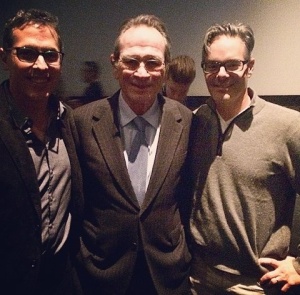
Below The Line Screening Series hosted a presentation of The Homesman at Arclight Cinemas, Hollywood, Nov. 10. The film’s writer, director and star Tommy Lee Jones, as well as its cinematographer Rodrigo Prieto, ASC, AMC, and composer Marco Beltrami sat down post credits for a Q&A.
The Homesman, based on the novel by Glendon Swarthout, tells the story of Mary Bee Cuddy (Hilary Swank) – a woman on a journey to save three other women who have been driven to insanity by harsh rural living. With the help of a drifter named George Briggs (Jones), the mentally ill women are wagoned through rural Nebraska to a church in Iowa.
When asked about working with Prieto on capturing The Homesman, Jones emphasized the challenges posed to the DP. Rugged terrain and intense day-to-night lighting shifts made for difficult camera, grip and lighting direction. “Rodrigo figured out how to shoot everything under impossible conditions,” said Jones.
Lighting conditions dictated the use of both film and digital cameras. “We ended up deciding to shoot the movie on film negative because we liked the texture of the film,” said Prieto. “He (Jones) wanted the beginning of the movie to feel like a Western. With a digital camera, the landscapes felt so pristine that it felt modern age. When we saw the same image on film negative, it felt like seeing a Western movie. It felt familiar.”
Although ARRI‘s Arricam LT achieved the look Prieto wanted during the day, he opted to use Sony‘s CineAlta PMW-F55 for extreme low lighting situations and night scenes. “We had all these deep dark scenes at night and when we tested film versus digital, particularly with the Sony, we realized that with the Sony we could shoot with candle light and oil lamps,” explained Prieto. “We added some grain to the digital scenes to match the film.”
Prieto explained that one of the big challenges was the crew’s constant battle with wind. Strong gusts and constant winds meant putting holes in large diffusion rags in order to fly 20×20 frames to control light. The presence of wind also meant that of clouds, changing the sun’s intensity and quality constantly, making continuity a tricky achievement.
Wind played another role in the filmmaking process in terms of score. Although, for Beltrami, it made for a positive and creative collaborator. “We took an old piano that was just deteriorating in an old lady’s basement and put it to use,” explained Beltrami. “We put it up on a hill and had the piano wires going 175 feet up the hill to these water tanks. When the Santa Ana winds would blow, we would record the sound it made. you could hear it from a mile away. You could actually tune the wind, it was amazing. You could also play the Piano.” Beltrami concluded by explaining some orchestral recordings were conducted outside to blend with the wind as well.
The Homesman will have a U.S. limited theatrical release Nov. 14.





